
 |
'East with the Night': Hilo,
Hawaii - Salinas, California
|
This is a long page about a boring and fortunately uneventful flight. It was a very easy flight and the weather was excellent along the whole route. However, it was a marathon in terms of range and duration. It was the longest flight I had ever done: a great circle distance of 2026 NM and a duration of 14 hours and 9 minutes. Preparations: How to cross the Pacific?Any aviator who considers flying around the world or crossing the Pacific worries about how to cross the huge expanse of water called the Pacific Ocean. So did we!! Basically there are 3 routes: Two North Pacific routes and one South Pacific route: i) North via Christmas island, Hawaii, Midway island the Aleutian
islands and Alaska The first one has shorter legs (Midway Island to Adak Island is only 1395 NM), but involves a large detour to the north. Furthermore March is not exactly the ideal time of the year to visit Alaska. Also the Aleutian islands are famous for some of the worst flying weather in the world and airframe icing can be a real killer. Not attractive at all!! The two other routes both involve long legs of slightly more than 2000 NM: Hilo, Hawaii to Monterey, California is 2012 NM and Easter Island to Santiago, Chile is 2025 NM. The Hawaii to California route is by far the most frequently flown and there is no problem with availability of AVGAS. The South Pacific route requires prior shipment of drums of AVGAS fuel to both Totegegie in French Polynesia and Easter Island. The weather is in general much more benign for these two routes than for the first route via Aleutian islands and Alaska. We had already available an approved and easy to install 35 US Gallon auxiliary tank on the rear seat since our trip to Brazil in 1996/97, increasing the total fuel capacity to 123 US gallons or 15 hours of economy cruise of about 148 knots at 8 US gallons per hour. This gives a no reserve range of about 2200 NM or only about 1 hour's reserve for the longest leg of the two southernmost Pacific routes. Not at all enough reserves!! We needed more fuel. The problem with the short bodied Mooney M20E is that it has a very restricted centre of gravity range. It is therefore not possible to add more fuel than what I had already at the location of the rear seat. The 34 USG Monroy tanks in the wings are also at the rear seat CG location. So the only solution I found to get Honey Mooney safely across the Pacific was: i) Design, build and get approved another fuel tank (27 US Gallons)
to be installed at the location of the co-pilot's seat Although the centre of gravity properties of the short body M20E limits the amount of fuel which can be installed on the rear seat it has a big advantage compared with the more recent M20J (Mooney 201) models: it is almost 200 lbs lighter with the same wing and engine: my empty weight is less than 1700 lbs. With the numerous speed kits installed, Honey Mooney is also faster than most 201's. Since there is no co-pilot on board, I needed no additional overgross authorization above the 15% overweight take-off weight associated with the previous tank approval in 1996: 2960 lbs. This is only slightly more than the standard 2900 lbs maximum take-off weight of the latest M20J model: Mooney MSE. So unlike many M20J which often takes off with 180 US gallons for the California - Hawaii leg (take-off weight around 3300 lbs!!) I suffered little initial weight related cruise performance penalty at or below 9000 feet. Which is why I needed less fuel than most M20J's need for the same leg. I started (too late!!) the design of the tank in August 2001, and after numerous exchanges and discussions with FOCA in Bern (Federal Office for Civil Aviation) the design paper work for the welded aluminium tank was finally approved 22 September 2001. The tank was built and installed, and the work report and the 'Aircraft Flight Manual Supplement' sent to Bern 18 October 2001. The final approval was received 22 October 2001 and the tank test flown the following day - just a week before our scheduled departure! This was a lot of work and expense. In addition, after 11 September, the US FAA issued several NOTAM's (FDC 1/3355, 1/3356 and 1/3359) which basically prohibited all foreign private aircraft (except Mexican and Canadian registered) from operating in the United States. Unless we obtained a waiver, these NOTAMS would stop us from using the two northernmost routes and we would have to go via Totegegie and Easter Island. We obtained a waiver from FAA in Washington DC the 12 February 2002, just before leaving New Zealand, and decided then to ship the tank to Hawaii. The flightAnother useful bit of information was a report from the UK weather office prepared for another earthrounder, Claude Meunier for the leg Hawaii - Los Angeles. It contains statistical integrated winds aloft information month by month and at various flight levels from FL100 to FL240. It indicated that we statistically would have a good chance for a tailwind, so we hoped we would not have to wait too long for favourable winds aloft conditions. This information was confirmed by Jim Hazelton when we met him on Christmas Island. After having finished the 50 hour service, installed and tested the additional fuel tank, I started to look at the weather. Friday 22 March there was a nice low about 500 NM west of Oregon, and although some clouds and rain were forecast for the Bay area, I would have a 30 knot tailwind for the second half of the leg and little headwind for the first half. However, I had only had 6 hours sleep the night before (..internet duties!!) and I was not ready to leave. Saturday morning I looked again, and although the depression was forecast to be over Oregon at the time of arrival and therefore produce less tailwind near California (NW winds) the winds aloft forecast was still good enough. In addition, the little bit of weather near California would be out of the way by the time I got there Sunday morning. From the satellite IR (infrared) photo it was clear that I would meet absolutely no weather along the whole route. Why fly during the night? It is unavoidable to fly some hours at night. After a 14-hour eastbound flight and losing two hours due to change of time zones, the local California landing time would be 16 hours after the local Hawaii take-off time. Many pilots prefer to leave around 10 PM local time as this results in an arrival time around 2 PM which is optimal for the coastal fog common along the California coast during the summer. During winter and early spring, the California coastal fog is less common. For Saturday 23rd and Sunday 24th March no low stratus clouds or fog were forecast for either Salinas, Monterey or San Josť, so I preferred to leave a bit earlier at 5 PM so I could arrive sooner but still in daylight. I had entered waypoints every 2 degrees of longitude (about 130 NM apart) along the great circle track from Hilo to Salinas. I was cleared 9000 feet and 'as filed'. The weather was very nice the whole way and I had (as expected) only a slight headwind component of 3 to 4 knots for the first couple of hours. I knew that the moon would keep me company for 8 1/2 hours out of the 10-hour night, which was comforting in case of an autopilot failure (vacuum pump failure) as I would have a natural horizon most of the night. Every 50 minutes I called up San Francisco with my position reports on HF and they all went through without trouble except once when I was reported 'weak but readable'. So I was not alone! During the evening the HF channel was very busy with airline position reports while later during the night it became much more quiet. Every time I made a position report I also wrote down the measured wind vector so I could compare it with the forecast - see the winds aloft forecast shown. It agreed fairly well, but I had slightly more headwind than expected during the first third and the tailwind component forecast approaching California was smaller than anticipated as the depression had moved east faster than forecast and the wind veered further to the NW. After a couple of hours the south easterly wind veered east and gave for 20 minutes or so a 10 knot headwind. I asked for FL110, and fortunately the wind veered back to SE and I had only the usual 3-4 knot headwind. The wind then decayed to less than 3 knots in the middle before picking up from the north as forecast. It then soon veered to the NW, increased to 30 to 35 knots and was an almost pure crosswind for some time until for the last couple of hours it gave a 5 - 10 knot tailwind component. How to keep awake during a 14-hour flight? The Brittain 3-axis autopilot flies the plane very well, so all there was to do is to manage the fuel tank switching and accounting, make position reports every 50 minutes or so and check the engine instruments, fuel flow and navigational situation every couple of minutes. The scenery was pretty with the moon illuminating the low clouds below. I was happily watching the familiar big dipper and the polar star which we had not seen for months as we were in the southern hemisphere. During the 10-hour night, I saw the big dipper swinging almost 180 degrees around the polar star. Watching stars and clouds was not enough to keep me awake. And the amount of traffic at FL110 across the Pacific at night does not justify looking for other traffic! For the last couple of weeks, I had been reading Thurston Clarke's 'Searching for Crusoe', A Journey Among the last Real Islands - very interesting reading indeed. So I spent several hours reading a couple of chapters while checking the instruments every time I turned a page. In addition, I had bought a couple of DVD's in Hawaii, and intended to watch them on the DVD player on my laptop. One of them was 'South Pacific', which I had not seen since I was a teenager. And it was interesting since we had just spent more than a month in the South Pacific. I had forgotten that there were also some nice flying scenes involving Grumman Goose and Japanese Zeroes in the movie. I can connect the audio of the laptop to the stereo music input of the intercom, so I got nice stereo sound from the movie. We also have a small CD player, which can play MP3 CD's with each about 10 times as much audio time as a regular CD. The sun rose as expected about 3 hours before landing above a compact low cloud cover. San Francisco was keen to pass me on to the Oakland Center on VHF, and I finally got VHF contact with them about one hour before landing. Soon I caught sight of the Monterey peninsula. Monterey and Salinas weather was better than forecast and I could make a quick visual approach into Salinas. My friend Jonathan Paul was waiting for me on the ground to receive me. Jonathan is best known amongst Mooney aviators for organizing the first Mooney Caravan into Oshkosh in 1998 (Madison to Oshkosh Mooney group arrival). It has been a regular and successful annual event ever since, and I had the great pleasure to participate in the Mooney Caravan 2000 as one of the first European Mooney's to join. It was great to be on the ground again! Jonathan had even pulled his Mooney out of his hangar to make room for mine. He then drove me to his lovely home at a great and quiet location on top of a hill between Salinas and Monterey, served me a well deserved breakfast, after which I went to bed and slept like a log until 5 PM. Jonathan was then so nice to lend me his car, so I could drive up to San Francisco International airport the same evening to pick up Angela and the co-pilot's seat. The following day Angela and I worked on getting the 27 USG tank out again, re-installing the co-pilot's seat and getting it packed up for shipment back to Switzerland. We thoroughly enjoyed Jonathan's hospitality and it greatly contributed to a speedy recovery from the long flight. Jonathan cooked us a wonderful salmon dinner, which he unfortunately could not even enjoy as he is following an ultra-strict diet to fight a prostate cancer diagnosed 7 months ago. But he was fully rewarded the following day as he received very positive biopsy test results confirming the incredible succes of this treatment. Jonathan and Gayle, we share your joy! Thanks: Eliot Merk, Jonathan Paul, Claude Meunier |
Click on image to
enlarge, click browser back to return
|
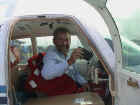 Surrounded in the cabin by life raft, survival gear and 72 US Gallons of fuel: 35 USG on the rear seat and 27 USG in place of the copilot's seat |
|
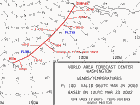 A reliable winds aloft forecast is essential for a 2026 NM ocean crossing. The forecast is compared with actual wind observations (red numbers) during the flight. |
|
 To my great surprise I managed to make a smooth touchdown in Salinas after 14 hours and 9 minutes in the air. Photo: Jonathan Paul |
|
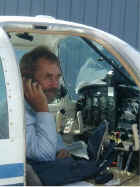 First priority was to call Angela in Hilo and report that I was safely on the ground. Photo: Jonathan Paul |
|
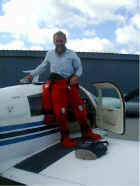 After sitting for more than 14 hours it was great to stand up again! Photo: Jonathan Paul |
|
 Jonathan kindly pulled his Mooney out of his hangar, so I could take the tank out and reinstall the front seat in a sheltered place. Photo: Jonathan Paul |
|
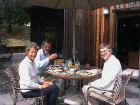 Lunch with Jonathan on his terrace |